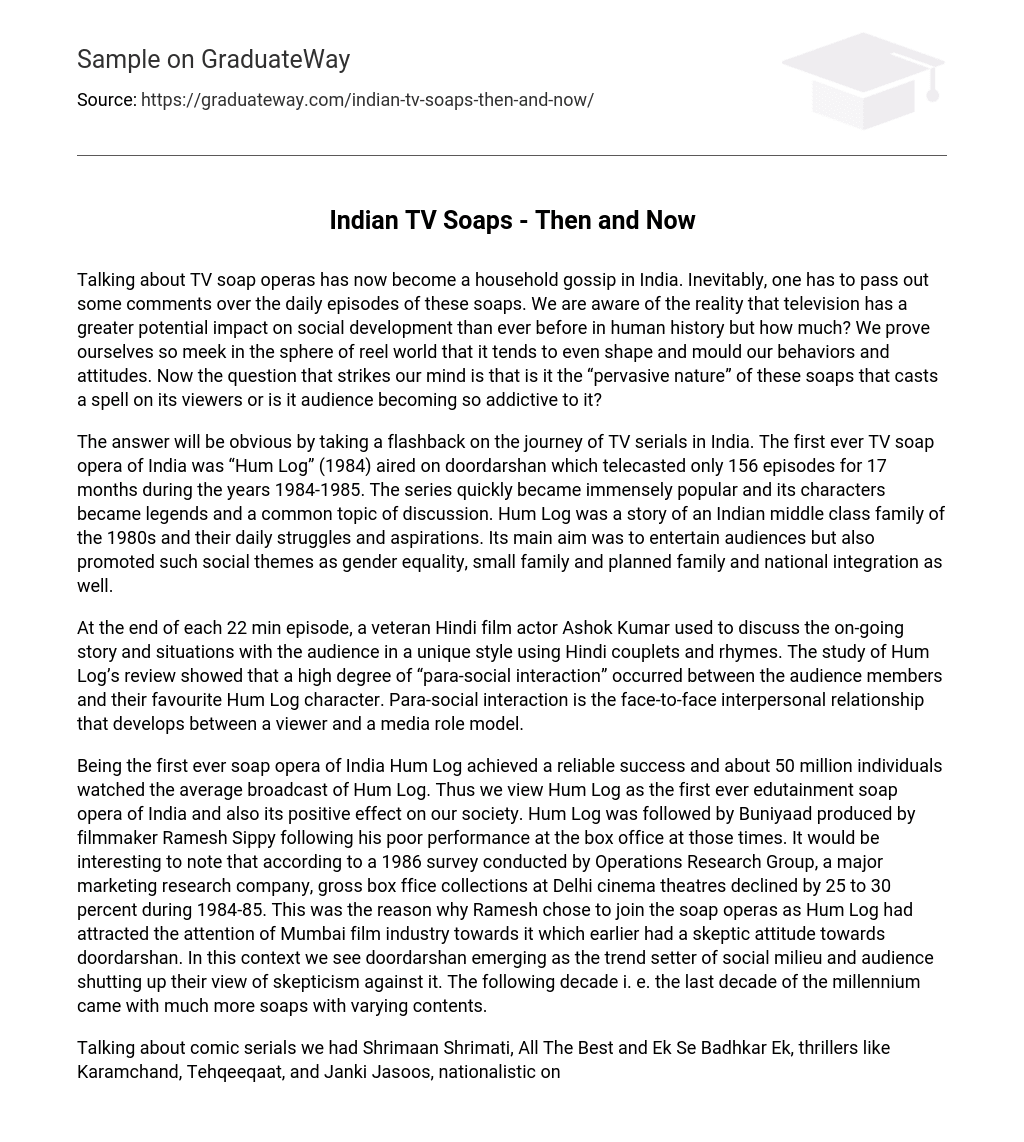The undeniable prevalence of discussions about Indian TV soap operas in households highlights their impact. People inevitably share their thoughts on the daily episodes of these shows, recognizing that television now has a stronger influence on social development than ever before. However, it is crucial to question the extent of this influence. We often find ourselves easily influenced by the fictional world portrayed on TV, shaping our behavior and attitudes. This raises the query of whether viewers are enthralled by the all-encompassing nature of these soap operas or if they have developed an addiction to them.
Taking a flashback on the journey of TV serials in India reveals that the first ever TV soap opera in the country was “Hum Log” (1984) on doordarshan. This show aired for 17 months, consisting of 156 episodes, from 1984 to 1985. It quickly gained immense popularity, with its characters becoming legendary and a common subject of discussion. “Hum Log” depicted the struggles and aspirations of an Indian middle class family during the 1980s. While its main goal was to entertain viewers, it also promoted social themes like gender equality, small family size, planned family, and national integration.
At the conclusion of each 22-minute episode, veteran Hindi film actor Ashok Kumar would engage in a distinctive discussion with the audience, discussing the ongoing story and circumstances using Hindi couplets and rhymes. Analysis of the reception of Hum Log demonstrated a strong level of “para-social interaction” between audience members and their beloved Hum Log character. This para-social interaction refers to the interpersonal relationship that develops between a viewer and a media role model.
Hum Log, the first ever soap opera of India, achieved considerable success with an average viewership of about 50 million individuals. Therefore, we consider Hum Log to be the pioneer edutainment soap opera in India and acknowledge its positive impact on our society. The success of Hum Log led to the creation of Buniyaad, produced by filmmaker Ramesh Sippy in response to his previous box office failures. Interestingly, a 1986 survey conducted by Operations Research Group, a prominent marketing research company, revealed a 25 to 30 percent decline in gross box office collections at Delhi cinema theaters during 1984-85. This decline prompted Ramesh to venture into soap operas since Hum Log had successfully caught the attention of the Mumbai film industry, which had previously held a skeptical attitude towards Doordarshan. Thus, Doordarshan emerged as a trendsetter in shaping social norms and managed to overcome skepticism from its audience. Subsequently, the last decade of the millennium witnessed an influx of soap operas with diverse themes.
Talking about comic serials, Doordarshan had Shrimaan Shrimati, All The Best, and Ek Se Badhkar Ek. They also had thrilling shows like Karamchand, Tehqeeqaat, and Janki Jasoos. For those interested in nationalist themes, there were Hum Hindustani, Sea Hawks, Swaraj. Additionally, melodramatic shows like Jazbaat and Swaabhimaan were also popular. These shows were eagerly awaited by people who would gather at the homes of those who owned TV sets. Sunday was the day for history buffs to watch serials like Akbar-The Great, Chandrakanta, Panipat Ki Aakhri Jung, Mulla Naseerud Din, and Alif Laila.
These serials were well-received by the audience and were primarily watched for entertainment. Unlike today, they were only aired once a week. The introduction of Cable Satellite TV channels in India, with Sony and Zee Tv leading the way, brought a new trend of colorful and content-rich serials. As the new millennium approached, these channels became inundated with shows that focused on Saas-Bahu relations and family dramas (mainly created by Ekta Kapoor), primarily on Star Plus and later on Zee TV and other networks.
The impact on audiences was so alarming that many Bollywood actors also appeared in these soap operas. Ekta Kapoor’s “K” factor marked a turning point in the history of soap operas in India. Ekta Kapoor not only created Kyunki Saas Bhi Kabhie Bahu Thi, but she also vividly narrated Kahaani Ghar Ghar Ki and Kasam Se. These shows not only appealed to audiences but also influenced their perceptions, attitudes, and behaviors. They even revolutionized their whole outlook, including in Kashmir. The feminization of these serials still has a strong effect on our female viewers.
The influence of Ekta has imbued women with a feeling of superiority over men, like a captivating spell. Furthermore, the ongoing conversations about the latest episodes, which often revolve around their colleagues, indicate the strong grip these soap operas have on their viewers and how they impact their socio-cultural lives. However, after nearly ten years, these Saas-Bahu dramas closed down their businesses in response to changing audience preferences.
Now we have soap operas like Parvarish that contain socio-edutainment content, as well as others that depict clashes of cultures and melodramatic romances. One such example is Bade Achche Lagte Hain on Sony TV, produced by Ekta Kapoor and featuring her popular “K-serial” stars Ram Kapoor and Sakshi Tanwar. This serial is currently a big hit, thanks to Ekta’s celebrated genius and the transformation of characters like Paarvati becoming Priya and Mr. Jai Wallia becoming Mr. Ram Kapoor. Taking a closer look at the journey of TV soaps in India, the answer is “YES.”
These soaps have captured us and effortlessly control our fragile emotions, as we willingly surrender to their influence. We cannot deny being addicted to them, even though we may not understand why. This was a reminiscence, but now focusing on current soaps, we have “Parvarish” for children and “Kuch To Log Kahenge” among others. However, “Bade Achche Lagte Hain” still maintains high TRP ratings. Therefore, there is no escape from these captivating soaps. Fazil Qayoom, a student at Media Education Research Center, University of Kashmir, and a print journalist.





